Gustave Courbet (1819-1877)

The Grain Sifters
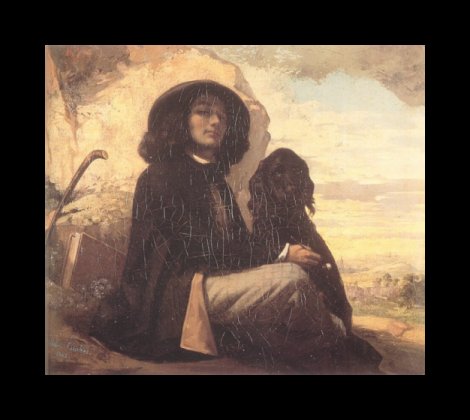
Self-Portrait with Black Dog
Get a Courbet Certificate of Authenticity for your painting (COA) for your Courbet drawing.
For all your Courbet artworks you need a Certificate of Authenticity (COA) in order to sell, to insure or to donate for a tax deduction.
Getting a Courbet Certificate of Authenticity (COA) is easy. Just send us photos and dimensions and tell us what you know about the origin or history of your Courbet painting or drawing.
If you want to sell your Courbet painting or drawing use our selling services. We offer Courbet selling help, selling advice, private treaty sales and full brokerage.
We have been authenticating Courbet and issuing certificates of authenticity since 2002. We are recognized Courbet experts and Courbet certified appraisers. We issue COAs and appraisals for all Courbet artworks.
Our Courbet paintings and drawings authentications are accepted and respected worldwide.
Each COA is backed by in-depth research and analysis authentication reports.
The Courbet certificates of authenticity we issue are based on solid, reliable and fully referenced art investigations, authentication research, analytical work and forensic studies.
We are available to examine your Courbet painting or drawing anywhere in the world.
You will generally receive your certificates of authenticity and authentication report within two weeks. Some complicated cases with difficult to research Courbet paintings or drawings take longer.
Our clients include Courbet collectors, investors, tax authorities, insurance adjusters, appraisers, valuers, auctioneers, Federal agencies and many law firms.
We perform Gustave Courbet art authentication, appraisal, certificates of authenticity (COA), analysis, research, scientific tests, full art authentications. We will help you sell your Gustave Courbet or we will sell it for you.
Gustave Courbet was the founder of what is known as the French school of Realism. Born into a wealthy farming family, he went to Paris to study law but finally decided to study art. Realism was a reaction to Romanticism and sought to show life as it really was, rather than romanticized idealist visions.
Gustave was determined in his art to portray ordinary places and people. He was a socialist and did not want to shy away from showing how life really was for some of the peasant population. He believed that art had a social and political role to play. He thought it could help eradicate social imbalances and make people aware of the injustices in Society. Later on in life his socialist leanings were to bring him a lot of trouble.
His first two paintings dealt with Literary subjects, but he quickly moved onto what he believed to be his true calling in art, painting life as it really was. He painted landscapes, portraits, nudes and still life as well as a number of seascapes. His first canvas to be accepted by the Salon was a self-portrait entitled ‘Courbet with a Black dog’.
A trip to the Netherlands in 1847 to see some paintings by the Masters there, only served to instill in him a determination to show the reality of everyday life. He admired greatly the works of Rembrandt, Hal and the other Dutch Masters.
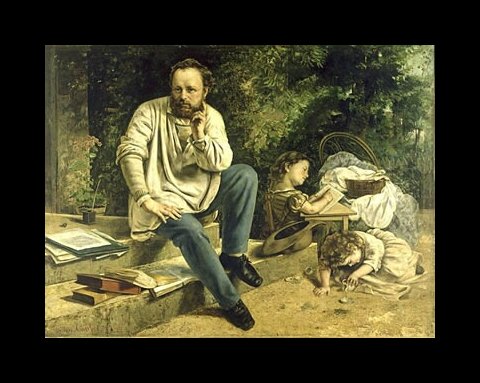
Pierre Joseph Proudhon et Ses Enfants en 1853
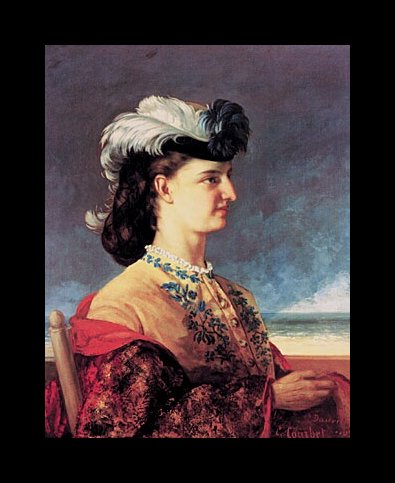
Portrait of Countess Karoly, 1865
Two separate visits to visit his family in Ornans served as inspiration for two of his masterpieces. The first painting produced in 1849 is entitled ‘The Stone-Breakers’ and the second in 1850 entitled ‘Burial at Ornans’ depicts what he saw at his Great Uncle’s Funeral in Ornans. The people at the funeral were used as his models and this was a new technique in painting of the day which caused some controversy at the time. His style which showed people in everyday situations such as at work or at funerals contrasted greatly with the style of Romantic painters such as Eugene Delacroix.
Speaking about his painting, ‘The Burial at Ornans,’ he said, ‘the Burial at Ornans was in reality the burial of Romanticism’.
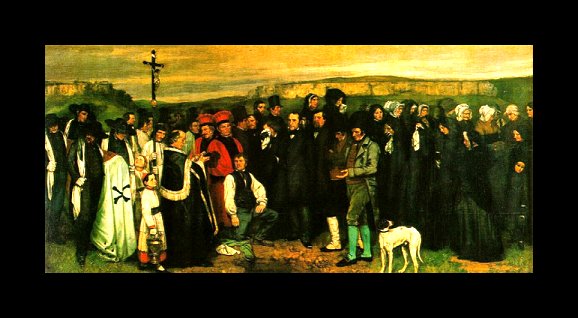
The Burial at Ornans, 1849-1850
He frequently returned to Ornans where the peasant community was an inspiration for his art.
Gustave Courbet was a rebel, and in 1855 when a huge canvas entitled ‘The Artist’s Studio’ was refused for an important exhibition, he boldly arranged for it to be displayed himself.
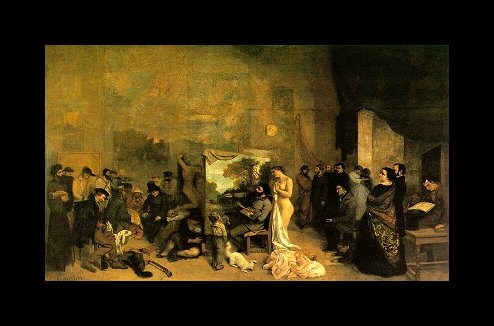
The Artist
His politics were intrinsically related to his art and in 1850 whilst speaking of his art he said, “… in our so very civilized society it is necessary for me to live the life of a savage. I must be free of even governments. The people have my sympathies; I must address myself to them directly.”
Towards the end of the 1860s he painted a series of erotic paintings, including one of two women in bed together. They caused an outcry and were banned from public display.
He refused the Legion of Honour which was offered to him by Napoleon III and immediately won the popular support of those that were opposed to the Government of the day. Under the revolutionary Paris Commune he was put in charge of the art museums of Paris and saved them from being looted. However, after the fall of the Commune he was arrested and accused of the destruction of the Vendome Column, a French monument. He was imprisoned for six months and afterwards was given a huge fine to cover the reconstruction of the column. He was unable to pay the fine and fled to Switzerland where he later died from liver disease, related to alcohol consumption.
He is the undisputed French master of the Realist school and as such his paintings are worth a great deal of money. A painting of his was entitled ‘La Belle Irlandaise’ sold in Sotheby’s in 1998 for nearly $3,000,000.
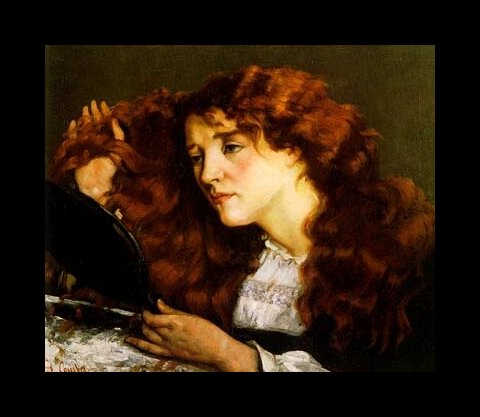
If you believe you own a work of art by Gustave Courbet, contact Art Certification Experts. We authenticate, appraise, research and provide Certificates of Authenticity (COA's) for works by Gustave Courbet.
Reviews
1,217 global ratings
5 Star
4 Star
3 Star
2 Star
1 Star
Your evaluation is very important to us. Thank you.
